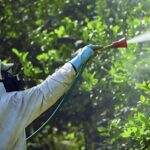The 6th International Agrochemical Formulation and Application Technology Summit (FAT 2025) will kick off in Hangzhou on November 13-14, 2025. Hosted by AgroPages, the event will bring together global agrochemical experts, enterprise leaders and technology pioneers to discuss cutting-edge trends and future paths for agrochemical formulations and application technologies.
Derek Oliphant—co-founder of UK-based Agbioinvestor and senior analyst for crop protection business—will be a key speaker. He will deliver a deep-dive report titled “European Agrochemical Formulation Trends: Mainstream Products, Regulatory Changes, R&D Reconstruction Driven by Application Technologies and Scenarios,” offering insights into the European market’s core dynamics and innovation directions for industry participants.
Europe: A Global Agrochemical Bellwether
Europe stands as a critical segment of the global agrochemical market, with its development and technological innovation drawing constant attention. AgbioInvestor latest news shows the European crop protection market reached $137.26 billion in 2024. Grains, fruits, vegetables and rapeseed are core demand drivers, while France, Germany and Italy contribute the largest market shares.
Notably, European agrochemical sales grew 2.1% from 2024 to 2025—outperforming major global regions. This growth stems from channel inventory recovery, improved weather conditions, the rollout of new formulation technologies and rapid penetration of biological products.
In product structure, the European market blends tradition and innovation. Non-patented products hold 76.4% of the market, making cost optimization and capacity integration key for enterprise competition. Proprietary products, meanwhile, keep breaking ground in high-value sectors thanks to patent protection and technical barriers.
For formulations, suspension concentrates (SC), emulsifiable concentrates (EC), water-dispersible granules (WG) and soluble concentrates (SL) are mainstream, accounting for over 60% of the market. Environmentally friendly options like microemulsions (ME) and microcapsule suspensions (CS) are also accelerating the replacement of traditional products, becoming R&D priorities.

Formulation Innovation: From Compliance to Efficiency
Strict European environmental regulations are reshaping agrochemical formulations. The summit will analyze R&D strategies under requirements such as low ecological toxicity, biodegradable additives and reduced active ingredient residues.
Discussions will cover how oil-dispersible concentrates (OD) solve application issues for water-sensitive active ingredients like sulfonylureas, and how water-based formulations balance safety and efficacy stability. Compatibility between microcapsule suspensions and biological agents will also be explored to support green plant protection.
With the average cost of launching new active ingredients hitting $301 million (2014-2019), enterprises are pushed to develop “compound formulations.” Combining new active ingredients with expired-patent components extends patent life and cuts farmers’ labor costs— a key practical topic at the summit.
Application Breakthroughs: Tech Integration
As “chemical + biological” synergistic pest control becomes mainstream, the summit will address biological pesticide formulation challenges. It will focus on boosting the stability of microbial products and plant extracts, including preventing active ingredient loss during storage and transportation, and optimizing formulations for post-dilution uniformity and spray droplet control.
Seed treatment will also be highlighted, with analysis of three technical paths (pelleting, coating, film coating) and how new materials (alginate, electrospun nanofibers, hydrogels) reduce microplastic pollution. Case studies will help enterprises tap into the seed health market.
Additionally, drone application is reshaping formulation demand. Limited drone load has driven ultra-concentrated formulations like ultra-low volume agents. Chinese enterprises lead in this field, and the summit will share ULV R&D focus, advantages and risk controls, building a global communication bridge.
Future Trends: Balancing Complexity and Green Transition
The agrochemical industry faces high R&D costs and green transition pressures. Since the 1950s, active ingredient synthesis steps have risen from 2-4 to 10-12, with more chlorination and fluorination use. The summit will explore synthetic route optimization to cut complexity, alongside topics like fluorine chemistry, new mechanisms of action and structure-activity relationship optimization.
Resistance management, differentiated expired-patent products and precision agriculture-formulation integration will also be discussed. FAT 2025 aims to offer solutions and cooperation opportunities for both traditional agrochemical firms upgrading technology and biological product companies expanding markets.










